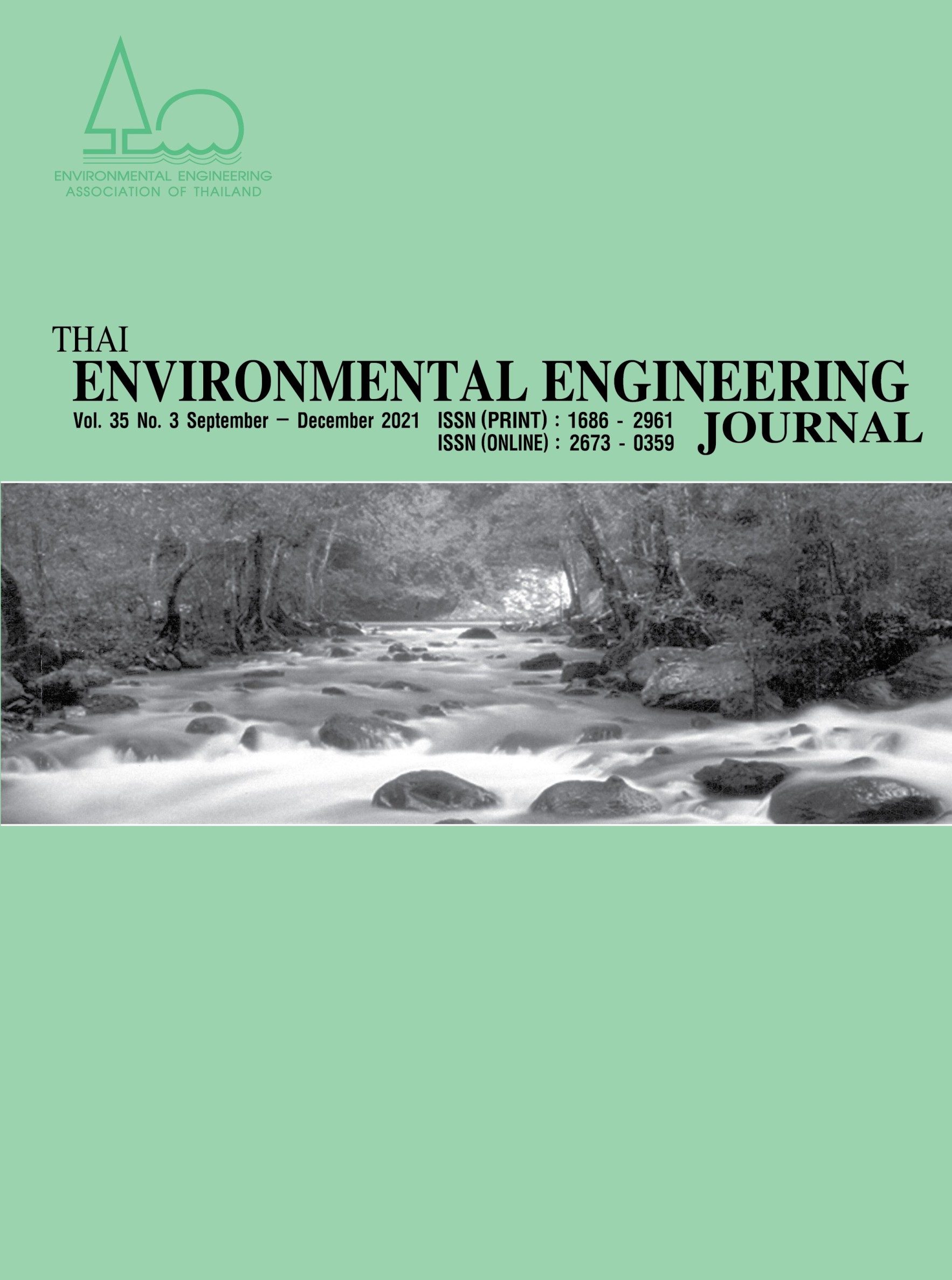Application of Air Purifier Filter Unit to Remove Particulate Matter in Semi-Outdoor System
Main Article Content
Abstract
PM2.5 and its chemical compositions are more concerned due to their impact on human health. This research characterizes particulate matter with the size of 2.5 µm and smaller (PM2.5) and total suspended particle (TSP) in three locations at Faculty of Engineering, Kasetsart University (Bangkhen Campus, Bangkok). Air purifier filter unit was utilized to collect particulate matter in order to determine the toxic metal components such as arsenic, cadmium, chromium, nickel, and lead by using the inductively couple plasma optical emission spectrometer (ICP-OES). The results showed that the daily average concentrations of indoor PM2.5 at locations L01, L02, and L03 were 61.5, 50.4, and 78.8 µg/m3, respectively. For all locations, only arsenic was found at location L03. With the concentration of 7 ng/m3 which were higher than the WHO standard. The air purifier filter unit helped to improve indoor air quality by reducing concentration of PM2.5. The average removal efficiency at locations L01, L02, and L03 proved to be 11.8%, 21.2%, 40%, respectively. However, the downstream concentration of PM2.5 was still higher than the indoor air quality standard (IAQ). Therefore, the air purifier filters should be further modified to improve the removal efficiency.
Article Details
References
Pollution Control Department. 2019. Plan for solving dust pollution problems.
USEPA. 2013. America’s Children and the Environment. 3rd Edition, Washington, DC, USA.
USEPA.2003. Particle Pollution and Your Health. [Accessed August, 20 2021]. Avaible from: https://www.airnow.gov/sites/default/files/2018-03/pm-color.pdf.
Fang, Yuanyuan, Dan, Miaomiao, Chunqian. 2018. Heavy metal characteristics and health risk assessment of PM2.5 in three residential homes during winter in Nanjing, China, Building and Environmental.143, 339-348.
Yuan, Fang, Songmin, Wenjie. 2021. Source analysis of heavy metal elements of PM2.5 in canteen in university in winter, Atmospheric Environmental. 244, 117879.
International Agency for Research on Cancer (IARC). 2012. Arsenic, Metals, Fibers, and Dusts, Volume 100C, A Review of Human Carcinogens. [Accessed August, 21 2021]. Available from: https://publications.iarc.fr/
Book-And-Report-Series/Iarc-Monographs-On-The-Identification-Of-Carcinogenic-Hazards-To-Humans/Arsenic-Metals-Fibres-And-Dusts-2012.
USEPA. 2018. Residential Air Cleaners, A Technical Summary. 3rd Edition, Washington, DC, USA.
ASHRAE 2016. ANSI/ASHRAE Standard 62.1-2016 Ventilation for Acceptable Indoor Air Quality, Atlanta, GA: ASHRAE.
Xin, Junjie, Xuan, Chaojun. 2021. Performance optimization of airliner cabin air filters, Building and Environment, 187, 107392.
World Health Organization (WHO). 2010. Preventing Disease Through Healthy Environments, Exposure to Arsenic : A Major Public Health Concern. [Accessed August, 25 2021]. Available from: https://www.who.int/ipcs/features/arsenic.pdf
WHO. 2000. Air Quality Guidelines for Europe, 2nd edition (WHO regional publications. European series ; No.91). [Accessed August, 20 2021]. Available from: https://apps.who.int/iris/handle/10665/107335.
Suthasinee M. 2010. Health Risk Assessment of Heavy Metals in the Offices’ Indoor Air. (master’s thesis, Kasetsart University).
USEPA. 1989. Risk Assessment Guidance for Superfund : Volume I, Human Health Evaluation Manual (Part A), Washington, DC, USA.
USEPA. 2011. Exposure Factors Handbook : 2011 Edition, Washington, DC, USA.
USEPA. 1991. Risk Assessment Guidance for Superfund : Volume I, Human Health Evaluation Manual (Part B), Washington, DC, USA.
USEPA. 2002. Integrate Risk Information System (IRIS), Chemical Assessment Summary : Arsenic inorganic ; CASRN 7440-38-2. [Accessed August, 26 2021]. Available from: https://iris.epa.gov/static/pdfs/0278_summary.pdf.


